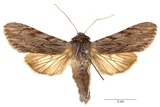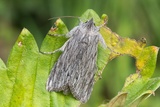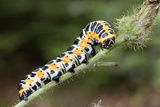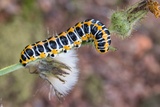Cucullia lactucae ([Denis & Schiffermüller], 1775) Species
Last modified: Nov. 18, 2025, 4:53 p.m.
This very rare species is found so far only a few times in our country and each time as a single caterpillar. During August 2019 many caterpillars were found in LX in the regio around Libin, where a stable population is probably present. Despite the brightly colored and easily recognizable caterpillars, this species is rarely found in the southern part of Belgium.
Details
- Classification
- Family: Noctuidae > Subfamily: Cuculliinae > Genus: Cucullia > Species: Cucullia lactucae
- Vernacular names
- Sla-monnik (NL), La Cucullie de la Laitue (FR), Lattich-Mönch (DE)
- First mention in Belgium
- Sibille J. 1912a. Captures et observations à Lamorteau-Torgny-lez-Virton au cours des deux étés derniers. — Revue mensuelle de la Société entomologique namuroise 12: 34–35. On page 35. view page
- Status
-
Native
Distribution
Imago
Wingspan 44–53 mm.
On the thorax a crest of long grey hairs in the shape of a hood (the cuculus of which the genus Cucullia takes its name), whose anterior point overhangs the head. Forewings grey, with veins delicately enhanced with dark and diffuse transverse bands.
Caterpillar
Reaches 50 mm. Whitish, with dorsal and bright orange-yellow lateral bands, separated by a subdorsal row of large black spots. It lives uncovered on its host plant; the vivid coloring of her dress, which is obviously aposematic, is supposed to indicate to a possible predator a probable unpleasant taste.
Bionomics
The caterpillar feeds preferentially on the flower buds, flowers, and immature fruits of its host plant and attacks the leaves only after they have been depleted. Pupation takes place in an underground cocoon. The pupation period can sometimes extend to several consecutive years.
The adult, of nocturnal manners, becomes active from dusk onwards, and rarely comes to light, as do those of most Cucullia species. During the day, it hides on the barks or on the stems, where its discrete livery makes it almost invisible.
Flight periods
The adults fly in one generation a year from late May to early August with a peak from mid-June till mid-July.
Observed on
- Host plant (species):
- Prenanthes purpurea
- Host plant (genera):
- Sonchus, Lactuca and Hieracium
The larva lives on different species of Asteraceae like Sonchus, Lactuca, Hieracium or Prenanthes purpurea.
Habitat
Especially in shaded to semi-shaded biotopes, particularly in various types of woodland and their edges, forest paths, clearcuts, but also in ruderal areas.






























